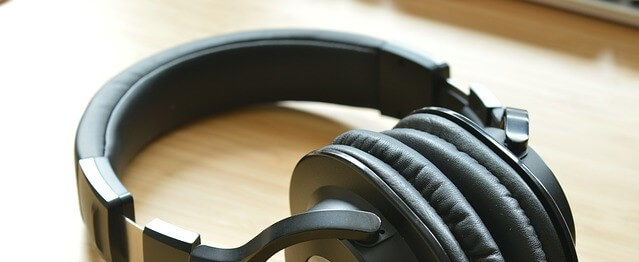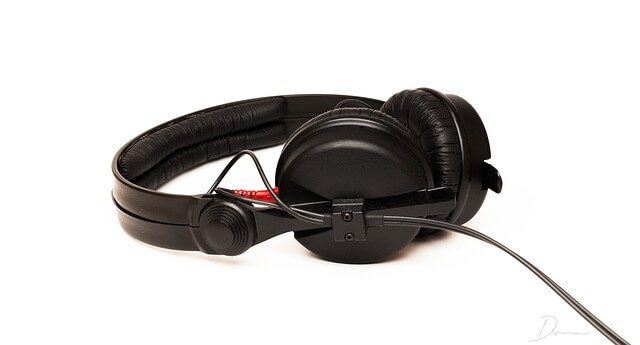
Audio Technica ATH M60x Review – Best On-Ear Studio Monitor?
Audio Technica ATH-M60x Studio Monitor Headphones
These cans are the “Batmobile of headphones”! Their all-black matte finish and durable appearance is enough to pique the curiosity of any serious headphone collector. Then again, it’s not exactly fair to judge a book by its cover.
As you know, an ultra-sleek appearance doesn’t always guarantee solid performance. How do these compare to the well-loved M50x? Are they better? Does their on-ear wearing design help, or hurt their overall performance? We’ll do our best to answer all of those questions, and more!
The main goal of our Audio Technica ATH M60x review is to help you decide whether or not they really are the best on-ear studio monitors! If you’re anything like us, you probably like to have all the facts before you make your decision! Before you dive into the first section, take a look at the brief overview below!
Audio Technica ATH M60x Review


Basic Features & Technical Specs:
- Closed-back, supra-aural (on-ear) wearing design
- Connectivity: Wired
- Driver Type: 45 mm large-aperture
- Frequency Response: 15 Hz – 28 kHz
- Impedance: 38 Ohms
- Sensitivity: 102 dB
- Includes: Large drawstring carrying pouch and 3 detachable cables (1 coiled/2 straight)
- Dimensions: 9 x 4 x 5 inches
- Weight: 7.04 ounces
Now, take a quick look at the links below! You can use them to skip ahead to your favorite section, or you can start from the top and browse the entire review!
Here are the 6 most important areas we’ll be covering in our overview:
- Are They Well-Built, or Cheaply-Constructed?
- Supra-Aural (On-Ear) Comfort
- Are They Better For Studio or Casual Use?
- Sonic Performance – 10x Better Than The M50x?
- Should You Add Them To Your Collection?
- Final Score (Out Of 10)!
Now that you have a better idea of everything we’ll be covering, you probably want to know if they’re well-built or cheaply constructed! Keep reading to find out!
Are They Well-Built, Or Cheaply-Constructed?
At the very beginning, we called these the “Batmobile of headphones”. If you were scratching your head as you read that, here’s what we mean. The ultra-sleek combination of black metal and matte finish plastic give these an appearance that seems to highlight a few main features.
- Power
- Stealth
- Performance
No matter which Batmobile is your favorite, you probably agree that each one exhibits all 3 features. Do these headphones also exhibit the same features, or is their appearance deceiving? (We don’t want to spoil the surprise right at the beginning, so you’ll have to keep scrolling.)
As you can see in the picture above, there is a single exposed wire (on both sides of the headband) that supplies the right and left ear cups with power. On the inside of the headband, you’ll also notice the small left and right indicators on either side.
Stock Ear Pads & Folding Design
The stock ear pads are covered with a soft leatherette material. They’re extremely plush and much thicker than most on-ear cushions. Although they’re somewhat shallow, it isn’t a bad feature at all since they sit on your ears, instead of over. (We’ll go into more detail about their comfort below.)
Unfortunately, they don’t fold into a smaller shape. While we agree that the lack of a folding design might be pretty disappointing, here’s the upside! Their extremely lightweight build makes up for some of the difference. They only weigh 7.2 ounces, which makes it pretty easy to carry them with you for portable listening.
Do The Ear Cups Swivel?
The second downside to their overall design is their lack of swiveling ear cups. Despite lacking the ability to swivel a full 90°, they do wiggle slightly back and forth. They have just enough wiggle room to automatically adjust to your specific head shape. Both ear cups also tilt inwards for the same purpose.
Headband Durability & Metal Sliding Adjustment
There is a single strip of metal underneath the headband padding. It isn’t quite as sturdy as the headband used on the M50x, but it is extremely lightweight and feels fairly durable.

Unlike the single headband-to-ear cup design on past models, these have an exposed metal sliding adjustment mechanism.
As you adjust the sliding headband adjustments on either side, you’ll notice a very subtle click. Each notch produces a satisfying but muffled tactile response that makes adjusting the headband even more enjoyable than usual.
3 Detachable Cables & Their Practical Applications
Another great feature these have to offer is their detachable cable design. It seems almost ludicrous that newer headphones (especially for studio use) don’t allow you to replace the cable. Luckily, these come with 3 separate cables for you to choose from.
You’ll receive one 4 ft. straight cable, a 10 ft. cable, and a 10 ft. coiled studio cable. Each cable twists and locks into the bottom of the left ear cup. You’ll also get two 1/4″ adapters to use however you see fit.
The detachable design and included cables have a few major upsides that you can see below:
- If the cable wears down, you don’t have to replace the entire headphone
- You get the option to choose from coiled or straight (and 4 ft. vs. 10 ft.)
- More listening flexibility
- The 10 ft. coiled cable is ideal for studio/podcasting
Logo-Branded Carrying Pouch
As is standard for headphones in this price range, you’ll also receive a large drawstring carrying pouch. It’s all black, with the logo branding you’d expect to see on the front. The case has plenty of room inside for your headphones, plus whichever cable and/or adapter you prefer. (You could also keep a small portable amp like the FiiO A3 inside if you needed to.)
Overall, these cans have an all-around solid build that also contributes to their performance versatility. Once again, the main downside in this area is their lack of folding design and swivel ear cups. Aside from that, there isn’t much to complain about. Since these are an on-ear headphone, comfort plays an even bigger role during longer listening sessions!
Supra-Aural (On-Ear) Comfort
Some people are automatically turned off by the idea of wearing on-ear cans for longer than an hour at a time. (If you made it this far, you probably don’t mind as much.) Sometimes it can start to feel like you’re taking a bigger risk in terms of comfort, which we totally understand.
Although some listeners immediately assume every on-ear is going to get uncomfortable much faster – the ear padding, headphone clamp, and headband padding also play a major role! Is it possible that these are as comfortable as a pair of over-ears?
Headphone Clamp – Too Much? Not Enough?
The thick ear cup and soft headband padding goes a long way towards making sure you can keep these on for hours at a time. They have fairly light (but definitely adequate) headphone clamp. It helps create a noticeably-improved wearing experience compared to most other on-ears.
That being said, after a few hours, you might start to notice some minor discomfort. Some minor discomfort honestly isn’t out of the ordinary at all for supra-aural cans.

If you wear glasses, that’s one of the only factors that might make them less comfy. Even though the pads are thicker than usual, they can start to cause more pressure than you might like after wearing them for an hour or more.
The soft leatherette ear pad covering provides decent ventilation. That, on top of the fact that they aren’t sitting all the way over your ears, dramatically decreases your chances of needing to take excessive breaks caused by over-heating.
One Possible Downside (It’s Not What You Think)
One possible downside that has less to do with comfort and more to do with how you’ll look when you’re wearing them, is their somewhat bulky ear cups. If you look at yourself in the mirror when they’re on your head, you’ll notice that they stick out pretty far on either side. Whether or not you think it’s a downside all boils down to your personal preference.
We usually lean towards judging their performance first, and how they look, second. If we haven’t mentioned any instant deal-breakers yet, let’s take a look at where they perform at their best!
Are They Better For Studio Or Casual Use?
The company advertises these as being perfect for studio monitoring or broadcasting. Do they live up to that promise? As we mentioned above, two major factors that contribute to their overall versatility are the cable options and extra length. Does their sound signature help, or hurt them in this area?
Are They Better For Analytical Listening?
First off, these have a detailed and natural-sounding profile (covered in full detail below) that definitely adds to their studio practicality. On most recordings, they tend to lean more towards an analytical sound signature.
If that was all they had to offer, it would make them less versatile than they actually are. Since their sound signature deserves a full explanation, we can’t recommend that you only use them for monitoring, recording, or podcasting.
They’re one of the few headphones that really excel in multiple areas. Before we ramble on too much about their performance versatility, there are a few more factors to consider.
Consider Their Noise Isolation
When you’re in the studio recording, mixing, or mastering, being isolated from your surroundings can be a plus, but isn’t necessarily the most important factor. That being said, if you record or mix in a home studio that isn’t completely soundproof, it can definitely help you focus.
For the most part, they isolate much better than many other on-ears. Although that’s true, it isn’t exactly surprising that they can’t compete with dedicated noise-cancelling headphones like the Sony WH1000XM2. If you’re a frequent flyer, they probably aren’t the best option.
They block just enough outside noise for most at-home, studio, and portable listening. Another great feature they offer is pretty minimal sound leakage. When your favorite album is blasting in your ears, anyone within a 3-5 foot range won’t be able to hear the lyrics or other detail that might disturb them.
The Most Versatile On-Ears You’ve Never Used
This is yet another feature that adds to their versatility. If you need a pair of ‘phones that you can use while you work at the office, library, or other quieter environment – these will work great. As we mentioned above, their sonic performance deserves a full explanation. Keep reading the section below to see how they sound!
Sonic Performance – 10x Better Than The M50x?!
Despite using identical drivers as the M50x, most people agree that these sound significantly better in every area. Of course, whether or not you agree depends on your personal taste. What’s really odd, is the fact that they sound totally different. How can two headphones with the same exact drivers each produce such a unique response?
Telling you that they sound 10x better might seem like a slight exaggeration, but once you read our detailed breakdown below, you’ll probably believe it! It’s hard to use words to describe their nuanced sound signature, but we’ll do our best to let you know what you can expect!
Depth, Imaging, and an Extremely Unique Sound Signature
The best way we can describe the way this sound is “completely immersive”. They have a good amount of detail which is further enhanced by their evenly-spaced lows, mids, and highs. This comfortable spacing creates a unique ‘airy’ effect that might make you question whether or not you’re still wearing headphones.
They sound surprisingly ‘natural’, as in, you feel as if you’re in the middle of the band as the song plays. They also have stand out imaging and depth. What does that mean in layman’s terms? Well, on a quality recording, you can feel the left, right, and center instruments/vocals gracefully weaving in and out.
The fact that they sound like they do while being both an on-ear and closed-back headphone are two major features that make their sound profile so impressive! So much so, that they might force you to re-think your previous opinion about on-ear cans in general.
Smooth & Extended Bass Response
In the low end, they have a very smooth extension. There is a surprising amount of depth that doesn’t muddy the rest of the track. Although the bass won’t violently shake any fluids out of your head, it might bring a tear to your eye when it reminds you about the first time you listened to headphones with a clean and refined bass.
Slightly Recessed Mid Range
On most recordings, instruments in the mid-range are slightly recessed. If you were to look at their frequency response on a detailed graph, you’d notice a slight dip after the impressively-extended bass response. Despite being somewhat recessed, the mid-range is never completely drowned out and rarely becomes an issue at all.
Top-Heavy Treble?
Vocals and instruments in the upper range are slightly laid-back (especially compared to top-heavy cans like the HIFIMAN HE 400i). That being said, it’s still very prominent and never goes unheard. If you’re used to purely flat reference cans, the treble will sound slightly sharper than you might be used to.
What’s The Bottom Line?
To put it bluntly – the M60x sound so much better than the M50x that it’s hardly even a fair competition. If you were to put both headphones in a boxing ring and have them exchange punches until one gave up – you can probably guess which one would remain standing.
Any on-ear headphone that can create such an immersive listening experience deserves a special place in your collection! Take a look at the final wrap-up below to see why you should (or shouldn’t) seriously consider grabbing a pair!
Should You Add Them To Your Collection?! – Why/Why Not?
There are only a few reasons why we wouldn’t recommend you add these to your personal collection. First, if you can’t stand wearing on-ears for longer than an hour, you should probably keep looking. Second, these probably won’t be ideal if you’ll be listening in extremely loud or chaotic places.
Aside from those two factors, they excel in almost every other area. While they can’t take the same level of punishment as some, they will easily withstand most everyday wear and tear. They’re perfect for listening at the office, at home, in the studio, or on-the-go.

They are also one of (if not the most) versatile on-ears, period. If you’re thinking about starting a podcast or getting into recording your own music – look no further. They’d be a great choice if you prefer feeling like you’re a part of the music (rather than a neutral bystander).
Before you click the link below, take a look at the table near the bottom to see how well they scored out of 10! We think it’s helpful to see one final pros/cons checklist and any other major features worth highlighting.
If you haven’t completely made up your mind yet, use the link below to see the most up-to-date pricing info, and/or more customer reviews.
Click Here To See The Best Price On Amazon!
What do you think? Did our Audio Technica ATH M60x review give you a good idea of what to expect? Do you agree that they’re the best overall on-ear headphone?
Leave a comment below and let us know what you think! If you have any questions, we’re more than happy to help! Thanks for taking the time to make it all the way through, we hope to see you here again!
- Korg B2 vs Roland FP10 | Which One To Buy - May 13, 2021
- How Does Music Affect The Brain? – Let’s Find Out! - April 6, 2021
- Why Are My Headphones Crackling? – How To Fix It - April 3, 2021